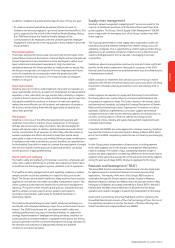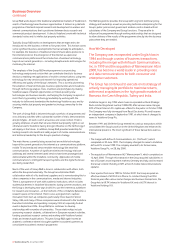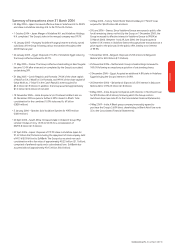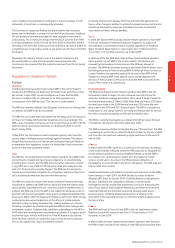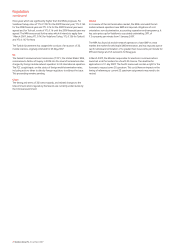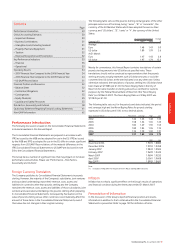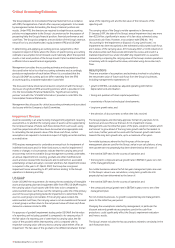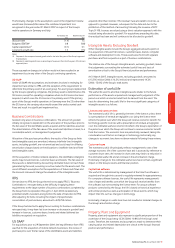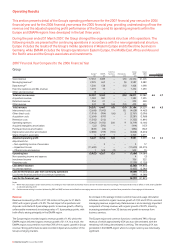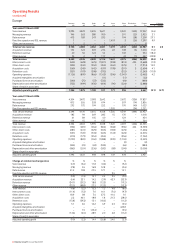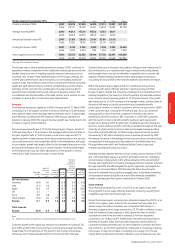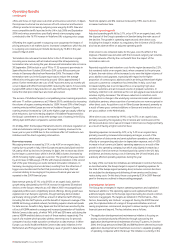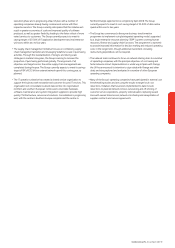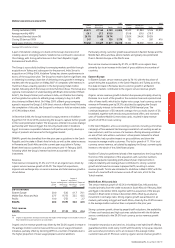Vodafone 2007 Annual Report Download - page 33
Download and view the complete annual report
Please find page 33 of the 2007 Vodafone annual report below. You can navigate through the pages in the report by either clicking on the pages listed below, or by using the keyword search tool below to find specific information within the annual report.
Vodafone Group Plc Annual Report 2007 31
The following changes to the assumptions used in the impairment review
would have (increased)/decreased the combined impairment loss
recognised in the year ended 31 March 2007 in respect of the Group’s
mobile operations in Germany and Italy:
Increase by 1⁄2% Decrease by 1⁄2%
£bn £bn
Discount rate (1.4) 1.5
Budgeted EBITDA(1) 0.8 (0.8)
Capital expenditure(2) (0.1) 0.1
Long term growth rate 1.7 (1.5)
Notes:
(1) Represents the compound annual growth rate for the initial five years of the Group’s approved
financial plans.
(2) Represents capital expenditure as a percentage of revenue in the initial five years of the Group’s
approved plans.
These assumption changes in isolation would not have resulted in an
impairment loss in any other of the Group’s continuing operations.
US GAAP
Under US GAAP, the assumptions and estimates involved in reviewing for
impairment are similar to IFRS, with the exception of the requirement to
determine the primary asset of an asset group. For asset groups represented
by the Group’s operating companies, the primary asset is determined as the
3G licence, except for operating companies where no 3G licence has been
acquired, in which case the 2G licence is the primary asset. If the primary
asset of the Group’s mobile operations in Germany were the 2G rather than
the 3G licence, the carrying value would exceed the undiscounted cash
flows and result in a significant impairment loss.
Business Combinations
Goodwill only arises in business combinations. The amount of goodwill
initially recognised is dependent on the allocation of the purchase price to
the fair value of the identifiable assets acquired and the liabilities assumed.
The determination of the fair value of the assets and liabilities is based, to a
considerable extent, on management’s judgement.
Allocation of the purchase price affects the results of the Group as finite
lived intangible assets are amortised, whereas indefinite lived intangible
assets, including goodwill, are not amortised and could result in differing
amortisation charges based on the allocation to indefinite lived and finite
lived intangible assets.
On the acquisition of mobile network operators, the identifiable intangible
assets may include licences, customer bases and brands. The fair value of
these assets is determined by discounting estimated future net cash flows
generated by the asset, assuming no active market for the assets exist. The
use of different assumptions for the expectations of future cash flows and
the discount rate would change the valuation of the intangible assets.
IFRS
On transition to IFRS, the Group elected not to apply IFRS 3, “Business
Combinations”, retrospectively as the difficulty in applying these
requirements to the large number of business combinations completed by
the Group from incorporation through to 1 April 2004 exceeded any
potential benefits. Goodwill arising before the date of transition to IFRS,
after adjusting for items including the impact of proportionate
consolidation of joint ventures, amounted to £78,753 million.
If the Group had elected to apply the accounting for business combinations
retrospectively, it may have led to an increase or decrease in goodwill and
increase in licences, customer bases, brands and related deferred tax
liabilities recognised on acquisition.
US GAAP
For acquisitions prior to 29 September 2004, the key difference from IFRS
was that for the acquisition of mobile network businesses, the excess of
purchase price over the fair value of the identifiable assets and liabilities
acquired other than licences (“the residual”) was allocated to licences, as
opposed to goodwill. However, subsequent to this date and due to the
prohibition of this method of accounting following the issuance of EITF
Topic D-108, licences are valued using a direct valuation approach, with the
residual being allocated to goodwill. For acquisitions preceding this date,
the residual has been and will continue to be allocated to goodwill.
Intangible Assets, Excluding Goodwill
Other intangible assets include the Group’s aggregate amounts spent on
the acquisition of 2G and 3G licences, customer bases, brands, computer
software and development costs. These assets arise from both separate
purchases and from acquisition as part of business combinations.
The relative size of the Group’s intangible assets, excluding goodwill, makes
the judgements surrounding the estimated useful lives and basis of
amortisation critical to the Group’s financial position and performance.
At 31 March 2007, intangible assets, excluding goodwill, amounted to
£15,705 million (2006: £16,512 million) and represented 14.3%
(2006: 13.0%) of the Group’s total assets.
Estimation of useful life
The useful life used to amortise intangible assets relates to the future
performance of the assets acquired and management’s judgement of the
period over which economic benefit will be derived from the asset. The
basis for determining the useful life for the most significant categories of
intangible assets is as follows:
Licences and spectrum fees
The estimated useful life is, generally, the term of the licence, unless there
is a presumption of renewal at negligible cost. Using the licence term
reflects the period over which the Group will receive economic benefit. For
technology specific licences with a presumption of renewal at negligible
cost, the estimated useful economic life reflects the Group’s expectation of
the period over which the Group will continue to receive economic benefit
from the licence. The economic lives are periodically reviewed, taking into
consideration such factors as changes in technology. Historically, any
changes to economic lives have not been material following these reviews.
Customer bases
The estimated useful life principally reflects management’s view of the
average economic life of the customer base and is assessed by reference to
customer churn rates. An increase in churn rates may lead to a reduction in
the estimated useful life and an increase in the amortisation charge.
Historically, changes to the estimated useful lives have not had a significant
impact on the Group’s results and financial position.
Capitalised software
The useful life is determined by management at the time the software is
acquired and brought into use and is regularly reviewed for appropriateness.
For computer software licences, the useful life represents management’s
view of expected benefits over which the Group will receive benefits from
the software, but not exceeding the licence term. For unique software
products controlled by the Group, the life is based on historical experience
with similar products as well as anticipation of future events, which may
impact their life, such as changes in technology.
Historically, changes in useful lives have not resulted in material changes to
the Group’s amortisation charge.
Property, Plant and Equipment
Property, plant and equipment also represent a significant proportion of the
asset base of the Group, being 12.3% (2006: 10.8%) of the Group’s total
assets. Therefore, the estimates and assumptions made to determine their
carrying value and related depreciation are critical to the Group’s financial
position and performance.
Performance


